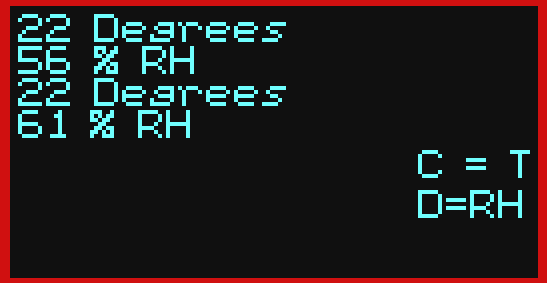Overview This tutorial describes how to write a simple KookaBlockly programme to blink a LED or sound a buzzer, and also how to write “ON” and “OFF” on the Kookaberry’s screen. A pdf of this Tutorial, as well as the two KookaBlockly programmes used in this Tutorial can be downloaded from within the LEDblink.kby.py zip file in the sidebar to …
Force of Gravity
Overview This resource is an experiential demonstration of the force of gravity. The force of gravity is what keeps our feet on the ground. We are all accelerating at around 9.8 metres per second per second towards the center of the earth. We can see this acceleration on the Kookaberry’s screen when resting vertically on a horizontal surface and running …
Measuring temperature and relative humidity- KookaBlockly
Overview This tutorial/lesson plan describes how to create two KookaBlockly programmes to measure Relative Humidity (RH) and Temperature using the DHT11 peripheral and the Kookaberry microcontroller STEM platform. One programme records constantly; the other at the press of a Kookaberry button. PDF documents for both programmes, as well as the resources and learning outcomes component, can be downloaded from the …
Blink a LED to send a distress signal
Overview The purpose of this sequence of resources is to allow teachers to complete most of the Stage 3 DT coding learning outcomes in just the single historical context of the electric telegraph and sending a distress signal The Kookaberry microcontroller STEM platform programmed using the KookaBlockly visual programming editor will be used as the basis for teaching the coding …
Apps to get you started
This Tutorial introduces some fun Apps (and some serious ones) to get you started using the Kookaberry straight out of the Class Kit box. No internet or WiFi access is needed to operate your Kookaberry. Only a few Apps will require you to connect a peripheral and no coding will be required. A pdf of this Tutorial can be downloaded …
Getting Started with KookaBlockly
Overview If you are familiar with Scratch or any other visual programming environment, this tutorial should provide just enough guidance to allow you to program your Kookaberry in real-time using KookaBlockly. You can download a pdf from the sidebar to the right. KookaBlockly Most visual programming editors are based in the cloud and require internet access. KookaBlockly, as well as …
Making 3D Printed Handles
This Tutorial provides all the information necessary to print your own 3D handle for a Kookaberry Specification Filament: PLA plastic, 17.08 grams Printing Parameters: 0.2mm extrusion with 15% infill Notes: No supports. Printed skirt or brim to help it stick to the printing plate. Each unit needs to be cleaned up by …
Introduction to digital systems
This Tutorial describes a digital system and uses the Kookaberry STEM platform to illustrate its fundamental principles What is a digital system? Digital systems receive information from Input devices such as a mouse, motion detector, microphone, or steering wheel, and make decisions (Processing) about what to do with the information depending on the circumstances. The decisions are transmitted to Output …
Pulse Width Modulation (PWM)
This Tutorial describes PWM and how it’s principles can be demonstrated using the Kookaberry ecosystem. Overview Specifically, this Tutorial will describe how the speed of a motor or the intensity of an LED is controlled in the digital world. The analogue world Our real world is generally an analogue world. Our eyes perceive a continuous range of brightness and …
KookaBlockly Workshop
This coding workshop/tutorial introduces participants to the KookaBlockly graphical coding editor. It requires at least two Kookaberries, a few selected peripherals and a PC to which the Kookaberry can be connected (tethered). It also needs a partner with another PC running KookaSuite for the interactive radio activities. However, these are just a small part of the whole workshop. Overview KookaBlockly …
- Page 1 of 2
- 1
- 2












